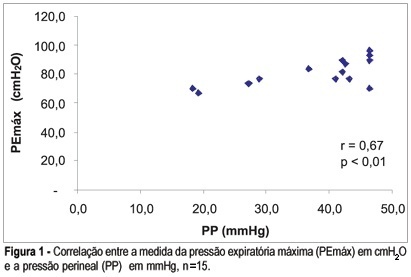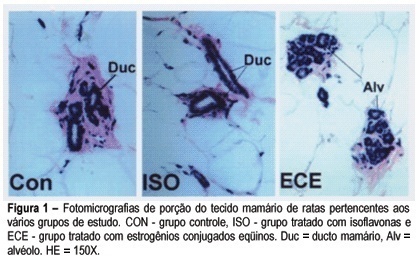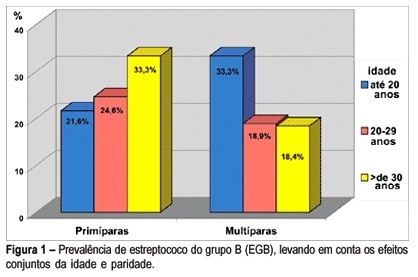Summary
Revista Brasileira de Ginecologia e Obstetrícia. 2005;27(4):210-215
DOI 10.1590/S0100-72032005000400008
PURPOSE: to verify the behavior of the abdominal and perineal musculature in respiratory changes induced in 15 nulliparous women without previous history of perineal or respiratory failures, with age ranging from 20 to 26 years (22.9±1.83). METHODS: the electrical abdominal and perineal activities were analyzed simultaneously through surface electromyography and perineal pressure (PP) obtained through digital biofeedback. The volunteers were told to accomplish three types of respiratory maneuvers: maximum inspiration (PImax), maximum expiration (PEmax) and Valsalva (VM), at random. The electromyographic signs were collected by the AqDados® (4.4) software for binary language ASCII, being processed later using the Matlab® (6.5.1) software. The statistical analysis of the envoltory (EN) of the signal was accomplished through Spearman correlation and Kruskal-Wallis test, and the level of significance was set at 5% (p<0.05). RESULTS: it was observed that PP was larger in PImax (2.98±2,38), followed by VM (29.10±10.68), both being overcome by PEmax (38.22±9,98) (p<0.01). A positive correlation between PEmax and PP (p<0.01), as well as between EN of the perineal and abdominal musculature in PEmax and PImax (p<0.05 and p=0,03, respectively) could be shown. The results regarding VM were not significant, when PP and EN were analyzed. CONCLUSION: it was possible to identify the presence of abdomino-pelvic synergy during the execution of breathing maneuvers, especially in relation to PEmax.

Summary
Revista Brasileira de Ginecologia e Obstetrícia. 2005;27(4):204-209
DOI 10.1590/S0100-72032005000400007
PURPOSE: to analyze the effects of isoflavones and estrogens on the morphology, morphometry and VEGF expression of the adult female rat mammary gland. METHODS: Forty-five adult female rats were oophorectomized; 28 days after surgery they were divided into 3 groups of 15 animals each: CON - control (treated with propylenoglycol); ISO - isoflavones (100 mg/kg) and CEE - conjugated equine estrogens (50 µg/Kg). Drugs or vehicle were given orally once a day for 60 days. After this, the animals were killed and the first pair of inguinal mammary glands was immediately removed; part of the material was processed for routine histological study and the remaining tissue was frozen for further analyses of the expression of VEGF mRNA by means of the RT-PCR technique. RESULTS: We observed that mammary ducts were atrophic in the control (CON) and isoflavone-treated (ISO) groups. In these groups the mammary glands were composed of a large concentration of adipose tissue with some ducts and rare alveolar structures. In the CEE group the ducts were well developed with many buds and alveolar structures. The number of mammary gland alveoli was higher in CEE than in the other groups (CON = 1.4 ± 2.1; ISO = 1.6 ± 3.8; CEE = 12.3 ± 7.1 alveoli/mm²; p<0.05%); also, the cell volume was higher (CON = 14.9 ± 4.9; ISO = 11.4 ± 6.9; CEE = 27.4 ± 9.7 µm³, p< 0.05%). The same was observed with regard to the number of blood vessels (CON = 16.4 ± 1.5; ISO = 18.4 ± 2.1; CEE = 37.1 ± 4.1 vessels/mm², p< 0.05). The expression of VEGF in the CEE group was higher than in the other groups, which did not significantly differ from each other in this respect. CONCLUSION: Our data did not show any proliferation effect in the mammary tissue of adult oophorectomized rats treated with isoflavones (100 mg/kg) during 60 days.

Summary
Revista Brasileira de Ginecologia e Obstetrícia. 2005;27(4):197-203
DOI 10.1590/S0100-72032005000400006
PURPOSE: to apply a severity score to cases of severe maternal morbidity (SMM) and to compare the classification criteria. METHODS: a control-case study was performed as a secondary analysis of cases of SMM in a tertiary level maternity unit for a period of 12-month. A specific score for assessing the degree of severity was applied to cases identified as SMM. Twenty cases of near miss maternal morbidity (higher severity) were compared to 104 control cases (lower severity) of other severe morbidities, regarding risk factors, primary determinants and assistance requirements. Analyses were performed with means and proportions, using Student's t, Wilcoxon and chi2 statistical tests, and estimations of OR and 95% CI. RESULTS: the higher severity (near miss) was identified in 16.1% of cases and the history of abortion was the only factor statistically associated with it (OR=3.41, 95% CI 1.08-10.79). In fact, the indices of assistance complexity were more frequent in the near-miss morbidity group, which also presented less hypertension (30% against 62.5%) and more hemorrhage (35.5% against 10.6%) as primary determinant factors of severe morbidity. CONCLUSIONS: the higher severity of maternal morbidity was associated with a history of abortion and with hemorrhage as a cause. The applied score was able to identify a higher severity subgroup (near miss), which needs more complex professional and institutional care in order to avoid the occurrence of death.
Summary
Revista Brasileira de Ginecologia e Obstetrícia. 2005;27(4):189-196
DOI 10.1590/S0100-72032005000400005
PURPOSE: to create a predictive model for cesarean section at the "Professor Monteiro de Morais Maternity" after evaluation of antepartum risk factors of the pregnant women who delivered from September 1, 1999 to August 31, 2000, and then, to verify the efficacy of indication for cesarean section. METHODS: a longitudinal, case control study with 3.626 pregnant women was performed to identify the antepartum risk factors for cesarean section in the period from September 1, 1999 to August 31, 2000. Thereafter an ideal model able to quantify the risk for cesarean section for each patient in the presence of one or more risk factor was created. Then, the model was applied to the patients of the study in order to verify the efficacy of indication for cesarean section. RESULTS: the baseline risk for cesarean section was 15.2%. The concordance between the percentage estimated through logistic model and cesarean delivery was 86.6%. CONCLUSIONS: the logistic model was able to identify the baseline risk for cesarean section and to quantify the increase in risk for cesarean section in each patient when risk factors were introduced in the model. The model can be considered efficient and able to predict cesarean section because the agreemant between the prediction and the correct indication was 86.6%, and 53.6% of the patients who had vaginal delivery did not have any risk factor for cesarean section.
Summary
Revista Brasileira de Ginecologia e Obstetrícia. 2005;27(4):181-188
DOI 10.1590/S0100-72032005000400004
PURPOSE: to estimate the prevalence of Family Health Program postpartum depression (PPD) and its association with minor mental disorders (MMD) among women attended in two (FHP) PSF units, in the city of São Paulo, and to identify risk factors associated with PPD. METHODS:a cross-sectional study with 70 postpartum women from two FHP units (Fazenda da Juta II and Jardim Sinhá), from October 2003 to February 2004. The following instruments were used: questionnaire with socio-demographical-economic data and obstetric and perinatal data; Self-Report Questionnaire 20 (SRQ-20), for screening of MMD, and Edinburgh Post-Natal Depression Scale (EPDS), for evaluation of PPD. To verify association between explanatory variables and PPD, Student's t test, chi2 or linear trend chi2 were utilized when indicated. To evaluate concordance between scales (EPDS and SRQ-20) kappa (kappa) coefficient correlation was used. RESULTS:the prevalence of PPD and MMD was 37.1%. Scales presented a good concordance (kappa=0.75). The explanatory variables age, ethnicity, years of education, profession, and marital status, besides partner's profession and years of education, familiar income, number of pregnancies, parity, miscarriage, number of alive children, premature deliveries, gestational age, type of delivery, planning of actual pregnancy, score of Apgar (first and five minutes), newborn sex and weight, and breastfeeding did not show significant statistical association. A greater perception of social support from the partner was associated with lower prevalence of PPD (p=0.03). CONCLUSION: because of its high prevalence and negative impact upon mother and child, it is worthwhile to sensitize health care professionals about the importance of PPD
Summary
Revista Brasileira de Ginecologia e Obstetrícia. 2005;27(4):174-180
DOI 10.1590/S0100-72032005000400003
PURPOSE: to determine the prevalence of group B Streptococcus (GBS) in pregnant women in the third trimester of pregnancy and explore the factors potentially associated with colonization. METHODS: a sample of 273 pregnant women in the third trimester of pregnancy, from the prenatal care center in Southern Brasil, was investigated. Vaginal and anorectal samples were collected and innoculated in Todd-Hewitt selective broth supplemented with 10 µg/mL colistin and 15 µg/mL nalidixic acid and afterwards cultured on defibrinated sheep blood agar plates. All suspected colonies were submitted to the agglutination test for detection of the specific group B antigen. The Camp test was used for GBS identification in non-hemolytic varieties. Demographic, socioeconomic, reproductive, and clinico-obstetric data were also analyzed. Prevalence ratio (PR) was used as risk measurement. Confidence interval was considered significant at the level of 95% (alpha=0.05). RESULTS: prevalence of Streptococcus (GBS) colonization amounted to 21.6% (59), 9.9% (27) of pregnant women showing positivity in both sites; vaginal site colonization was found in 6.95% (19) of the women and 4.75% (13) of the samples showed positivity only in the anal site. GBS prevalence was slightly higher in pregnant women under 20 years, in those with less schooling and in primiparae and was twice as high among those who did not reported spontaneous abortion, but with no statistical significance. No difference was found in GBS prevalence according to the history of sexually transmittted diseases and tabagism. When analyzed together, the factors detected as potentially associated with colonization by GBS were: primiparae over 30 years (PR=1.55) and women with more than one sexual partner and increased frequency of sexual activity (p<0.05) (55,6 vs 20.5%; p<0.05). No difference regarding prevalence was found to exist in relation to the history of sexually transmitted diseases, previous spontaneous abortion and tabagism. CONCLUSION: these results confirm the need for routine collection for GBS culture from both sites (vaginal and anal) in all pregnant women in the third trimester of pregnancy.

Summary
Revista Brasileira de Ginecologia e Obstetrícia. 2005;27(4):168-173
DOI 10.1590/S0100-72032005000400002
PURPOSE: to evaluate ophthalmic and retinal central artery Doppler indices during the second and third trimesters of normal pregnancy and to compare the right with left eye Doppler indices of normotensive women. METHODS: a cross-sectional study which evaluated central retinal and ophthalmic artery Doppler velocimetry values of 51 normal pregnant women, in the 20th to 38th week of gestation. The following values were analyzed: pulsatility and resistance indexes (PI, RI), peak systolic and end-diastolic flow velocity (PSV, EDFV) and peak velocity ratio (PVR). The Doppler indices in the right and left eyes were studied by the median. The paired Student's t test was used to confront the right and left eye values and the Pearson linear correlation analysis was performed to study the value changes throughout the gestation, with the level of significance set at 5%. RESULTS: Doppler velocimetry indices of ophthalmic and central retinal arteries (median values) were, respectively: PI=1.83; RI=0.78; PSV=34.20; EDFV=6.80; PVR=0.48 and PI=1.34; RI=0.70; PSV=7.40; EDFV=2.10. There was no significant difference between the right and left side Doppler values. Linear correlation analysis showed no association between the arterial values and pregnancy age. CONCLUSION: the unilateral analysis of ophthalmic and central retinal artery Doppler velocimetry values can be used in systemic maternal disease. There is no significant change in ophthalmic and central retinal artery Doppler velocimetry values throughout normal pregnancy.

Summary
Revista Brasileira de Ginecologia e Obstetrícia. 2005;27(2):80-85
DOI 10.1590/S0100-72032005000200007
PURPOSE: to evaluate the evolution of pregnancy and the maternofetal prognosis in women with uterine leiomyomas. METHODS: a descriptive retrospective analysis of the medical records of 75 pregnant women with leiomyomas attended at the University Hospital, Faculty of Medicine of Ribeirão Preto, University of São Paulo, from January 1992 to January 2002. RESULTS: seventy-five pregnant women with leiomyomas were identified in a population of 34,467 pregnant women attended during this period (incidence of 0.2%). The diagnosis was made before pregnancy in 18 patients (24%), during the current pregnancy in 41 (54.6%), and during cesarean section in 16 (21.3%), of whom only six were not submitted to ultrasound scan during the prenatal period. Ten deliveries with preterm fetuses and five cases of premature rupture of the amniotic membranes were observed. Forty-seven patients (75.8%) were submitted to cesarean section, with the indication being directly related to the leiomyomas in 38.3% of them (anomalous presentation, obstruction of the birth canal, or uterine scar due to a previous myomectomy). Four cases of central necrosis, two cases of hyaline degeneration and one case of malignant potential of the leiomyoma were identified in patients submitted to postpartum myomectomy or hysterectomy. Sixty-one newborns (98.4%) had an Apgar score above 7 at the fifth minute of life, and surgery did not lead to a worse maternofetal prognosis when performed during pregnancy. CONCLUSIONS: the incidence of leiomyomas during pregnancy was 0.2% during the study period, with ultrasonography failing to diagnose 10 patients. Cesarean section was frequently indicated for this group of patients, but the presence of leiomyomas during pregnancy did not compromise the Apgar score of the newborns.